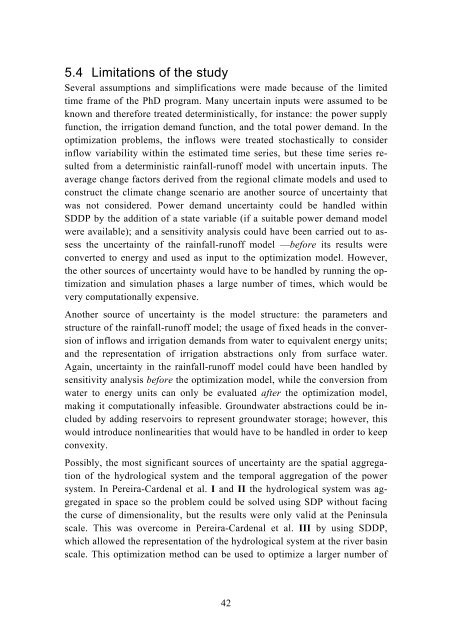A framework for joint management of regional water-energy ... - Orbit
A framework for joint management of regional water-energy ... - Orbit
A framework for joint management of regional water-energy ... - Orbit
You also want an ePaper? Increase the reach of your titles
YUMPU automatically turns print PDFs into web optimized ePapers that Google loves.
5.4 Limitations <strong>of</strong> the study<br />
Several assumptions and simplifications were made because <strong>of</strong> the limited<br />
time frame <strong>of</strong> the PhD program. Many uncertain inputs were assumed to be<br />
known and there<strong>for</strong>e treated deterministically, <strong>for</strong> instance: the power supply<br />
function, the irrigation demand function, and the total power demand. In the<br />
optimization problems, the inflows were treated stochastically to consider<br />
inflow variability within the estimated time series, but these time series resulted<br />
from a deterministic rainfall-run<strong>of</strong>f model with uncertain inputs. The<br />
average change factors derived from the <strong>regional</strong> climate models and used to<br />
construct the climate change scenario are another source <strong>of</strong> uncertainty that<br />
was not considered. Power demand uncertainty could be handled within<br />
SDDP by the addition <strong>of</strong> a state variable (if a suitable power demand model<br />
were available); and a sensitivity analysis could have been carried out to assess<br />
the uncertainty <strong>of</strong> the rainfall-run<strong>of</strong>f model —be<strong>for</strong>e its results were<br />
converted to <strong>energy</strong> and used as input to the optimization model. However,<br />
the other sources <strong>of</strong> uncertainty would have to be handled by running the optimization<br />
and simulation phases a large number <strong>of</strong> times, which would be<br />
very computationally expensive.<br />
Another source <strong>of</strong> uncertainty is the model structure: the parameters and<br />
structure <strong>of</strong> the rainfall-run<strong>of</strong>f model; the usage <strong>of</strong> fixed heads in the conversion<br />
<strong>of</strong> inflows and irrigation demands from <strong>water</strong> to equivalent <strong>energy</strong> units;<br />
and the representation <strong>of</strong> irrigation abstractions only from surface <strong>water</strong>.<br />
Again, uncertainty in the rainfall-run<strong>of</strong>f model could have been handled by<br />
sensitivity analysis be<strong>for</strong>e the optimization model, while the conversion from<br />
<strong>water</strong> to <strong>energy</strong> units can only be evaluated after the optimization model,<br />
making it computationally infeasible. Ground<strong>water</strong> abstractions could be included<br />
by adding reservoirs to represent ground<strong>water</strong> storage; however, this<br />
would introduce nonlinearities that would have to be handled in order to keep<br />
convexity.<br />
Possibly, the most significant sources <strong>of</strong> uncertainty are the spatial aggregation<br />
<strong>of</strong> the hydrological system and the temporal aggregation <strong>of</strong> the power<br />
system. In Pereira-Cardenal et al. I and II the hydrological system was aggregated<br />
in space so the problem could be solved using SDP without facing<br />
the curse <strong>of</strong> dimensionality, but the results were only valid at the Peninsula<br />
scale. This was overcome in Pereira-Cardenal et al. III by using SDDP,<br />
which allowed the representation <strong>of</strong> the hydrological system at the river basin<br />
scale. This optimization method can be used to optimize a larger number <strong>of</strong><br />
42
















